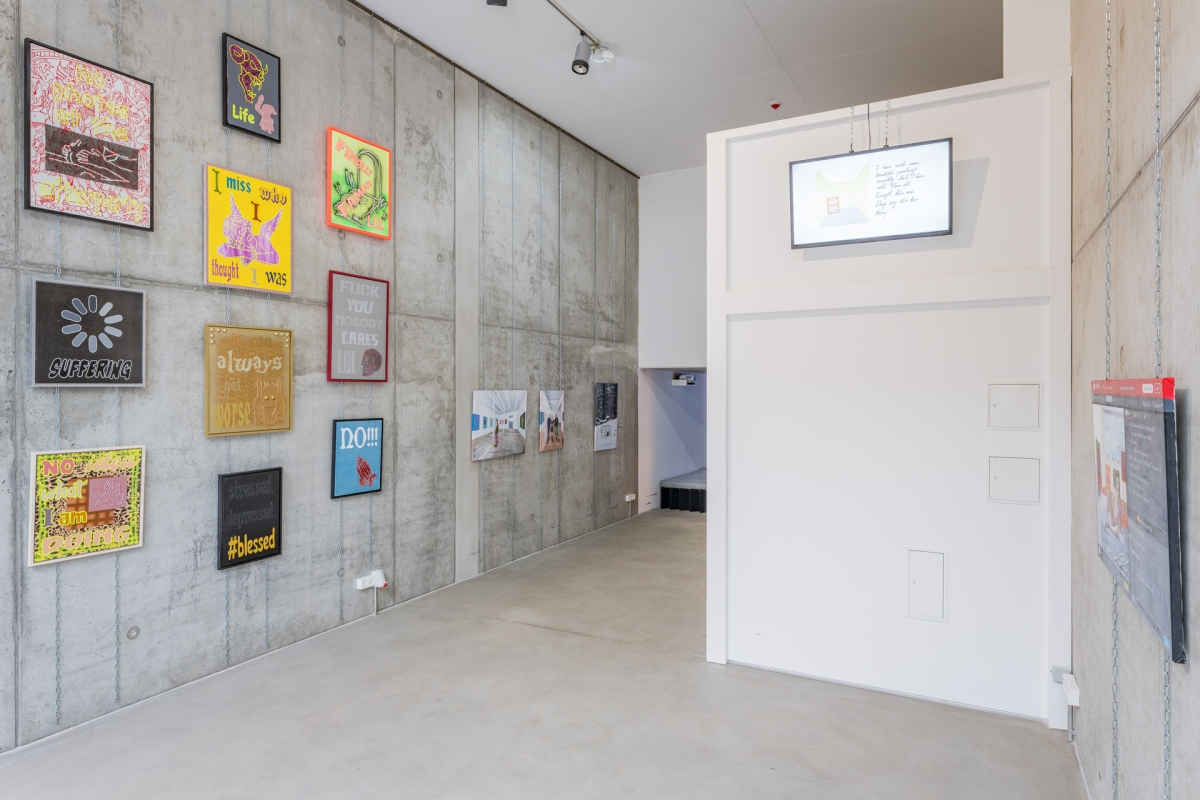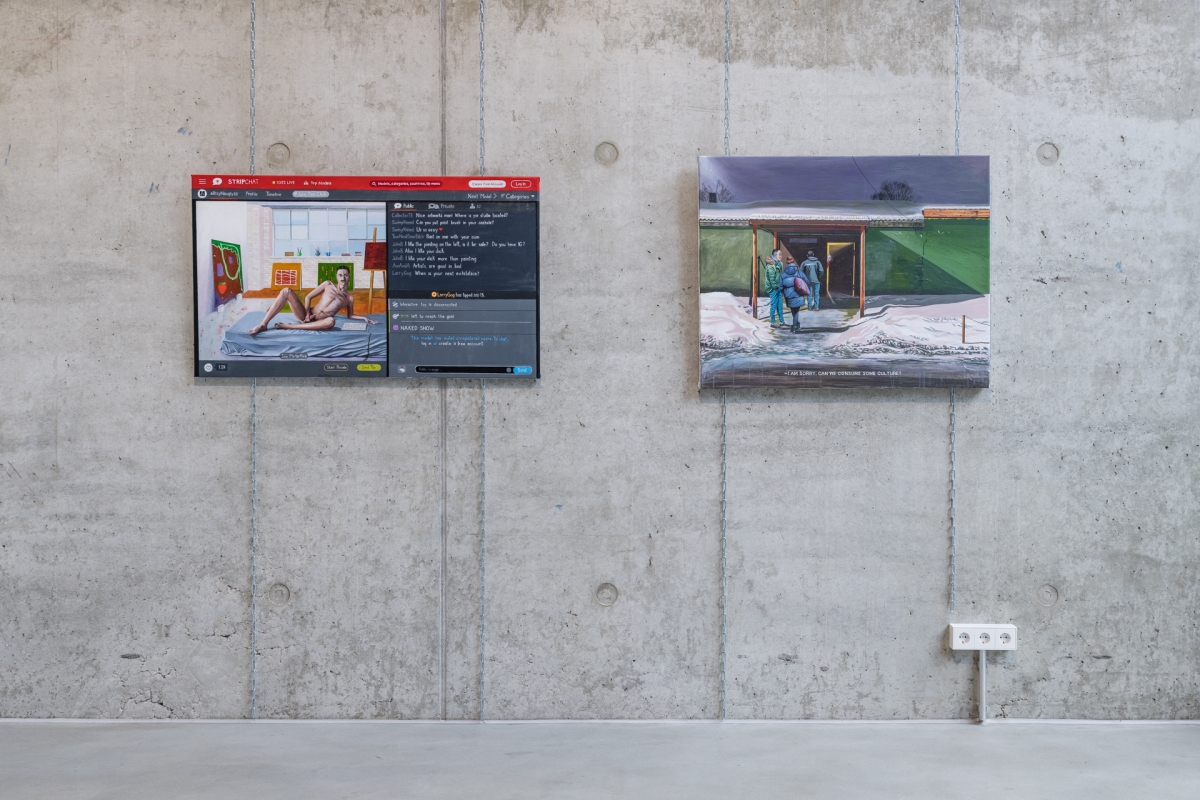It is a rainy Friday evening in the center of Berlin, a key calmly turns to open the gallery door, the light is bright, maybe a bit too bright so every tiny corner is shadowless. The walls are white, the floor is grey, the windows clean, small wine glasses are waiting in line, an intern doesn’t have to do anything anymore and stares into nothingness. Everybody waits for the relieving visitors but the nervous feeling that not so many people will arrive stays in the back of the mind as a loyal companion. The door opens and the first dirty shoes leave their traces on the spotless floor. Months of work, mostly solitary in the studio, with canvas and paper in front and expectations in the back, are now presented and visible to the public. The change of the scenery, to see the artworks in a different environment does have its beauty, the chance to focus more on the single piece without being distracted by the tightness of the studio and other sensory impulses. The space is filling up like the glasses with white wine, each artwork is granted with two to ten seconds of attention, a list with information is taken and folded, the noise increases and the chit-chatting evolves into a dense cloud of incomprehensible mumbling. All backs are now turned towards the artworks which hang like decorations of a social networking event silently by and for themselves. Here and there a finger is pointing at a detail, a selfie is taken in front of a work, the first sentences of the press release are scanned. Questions, anger and disappointment are loyal companions in situations like this but they are mostly safely stored behind strong bars covered by a masking smile. When the solitude hits with its full potential of silence and loud thoughts it is inevitable to make a decision which appears as black or white, going with the flow or against it, accepting or revolting. The artistic production hereby can turn into a medium of self-reflection and self-location, how to process experiences like this without letting frustration take too much space, to navigate through this jungle of white cubes surrounded by a black market.
And now a pandemic and its restrictions is causing a collapse of the gallery system and the connected way of selling art. After the first lockdown the scene could take a breath and everybody felt more prepared for the second wave but nobody knows which consequences the artists and cultural landscape will be confronted with in the long run, if there is a third lockdown coming, if galleries will close, institutions will not engage with the planning of the upcoming years, collaborations are put on hold – A survial kit for the art market is urgently needed.
The fact that being an artist nowadays comes with the certainty of an omnipresent struggle is already common knowledge. Capitalism and creativity are in most cases opponents and just weirdly go along with each other. Of course, there are always other examples but the normal relation between these entities is complex in terms of dilemma and paradox. How to be freely creative when the market is asking for another aesthetic? How to maintain a path of authenticity when the gallerist wants a certain topic and size of an artwork? The artist needs to juggle him/herself and the artistic production through this dense network of a constant overlapping of a necessary individualism as the medium of recognition and external expectation of the market and its players. But this story is not a story about victims, it‘s a journey of discovering how to survive within these conditions, how to preserve one‘s own aesthetic development from being too influenced by the environment and finally to use this situation as a potential, not as an obstacle.
Berlin as a hub and European creative center is a location where the poles of high and low crash into each other causing a wide gap between the establishment and the underground. This tension is fuel and danger at the same time and an implosion of this system is certain. Money walks on the same paths and is mostly difficult to redirect to the upcoming scene where it is needed the most. A survival kit is unavoidable to offer orientation and support. The kit evolves out of artists‘ observation and analysis to synthesise into visualisation. A constant review of one‘s opinions, positions and locations in this polarized art world is the topic of the artist residency taking place between March and May 2021 in Berlin which will be followed by an exhibition during the famous and rightfully criticised Gallery Weekend Berlin. The Estonian artists Alexei Gordin, Kennet Lekko and Marko Mäetamm will approach the topic a Survival Kit for the Art Market during their stay in Berlin, focusing on the madness, beauty, senselessness and necessity of the existence of the art market. After the show in Berlin the exhibition will travel to KOGO Gallery, Tartu which is from the beginning a part of the thematic reflection. The differences and wishes, expectations and failures of the artists regarding the European art market have their roots in Estonia and have extended from there. The urge to leave and come back will therefore be mirrored in the travelling exhibition, from Berlin to Tartu, with a survival kit to be safer in dangerous times of the art market.
Survival Kit for the Art Market
Alexei Gordin, Kennet Lekko , Marko Mäetamm
ROAM
Lindenstraße 90
10969 Berlin
https://www.roam-space.eu/
Exhibition Berlin
July 1st – 4th
exhibition Kogo gallery
July 10th – August 14th
Photography: Andreas Baudisch












































